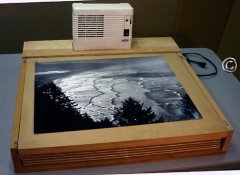To rwyoung - I do the back to back hanging thing for all my prints (no matter what size), with all four corners clothespin clipped, the top 2 on the line. They dry flat enough, less so in dryer times of the year. I wash them back to back (but in separate compartments) in a Gravity Works washer, then I pull them out just an inch or so, line up the top corners with the separator in between, then pull both out together and hang together.
I don't squeegee them (too much risk for me) and I suspect that the curling happens in the final stages of drying, so squeegeeing might help shorten the drying time, but I think relative humidity has more to do with the amount of curl, or "frilling" of the edges than anything.
I have tried all of the suggested methods, and for years, blotters, with the corragated separators, which produced the flattest prints, by far, but I got tired of worrying about lint and accumulated contamination, careful as I am.
Screens were ok, but often left a pattern, also need to be cleaned, and had curl.
The back to back hanging is the simplest and works best for me.
I just now did a search on Google for "photo blotters" and found this article - which aligns with most of my experiences -
http://www.heylloyd.com/technicl/drying.htm.
In any case, my experience is that no matter how flat they are (even if I flatten with a dry mount press after drying), if I store them in archival boxes, or old paper packets, the relative humidity the day I take them out to mount them is what really matters. Prints that were once perfectly flat might not be the day I take them out to frame them, so - I just hang them as described, and deal with whatever they are on the day I frame them.





